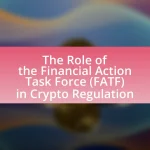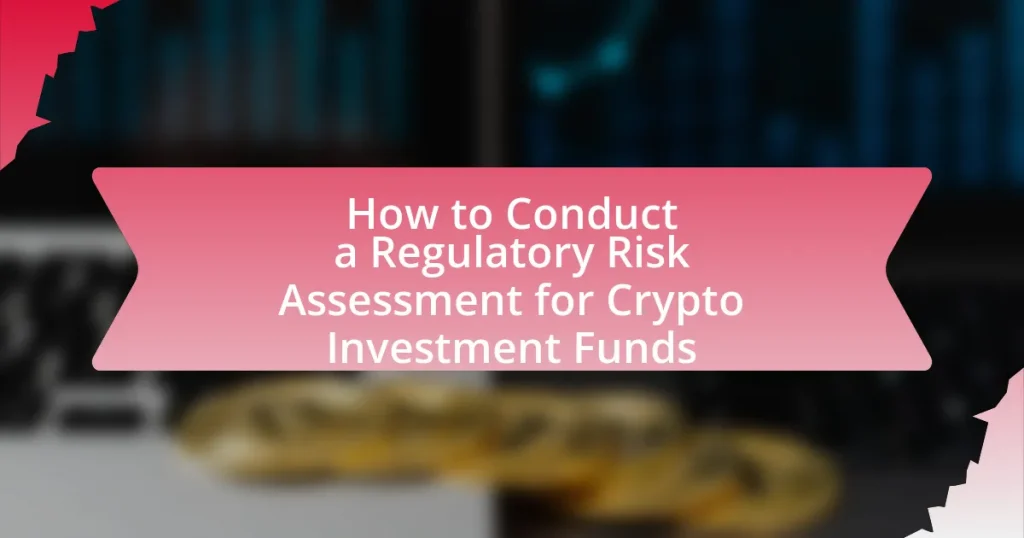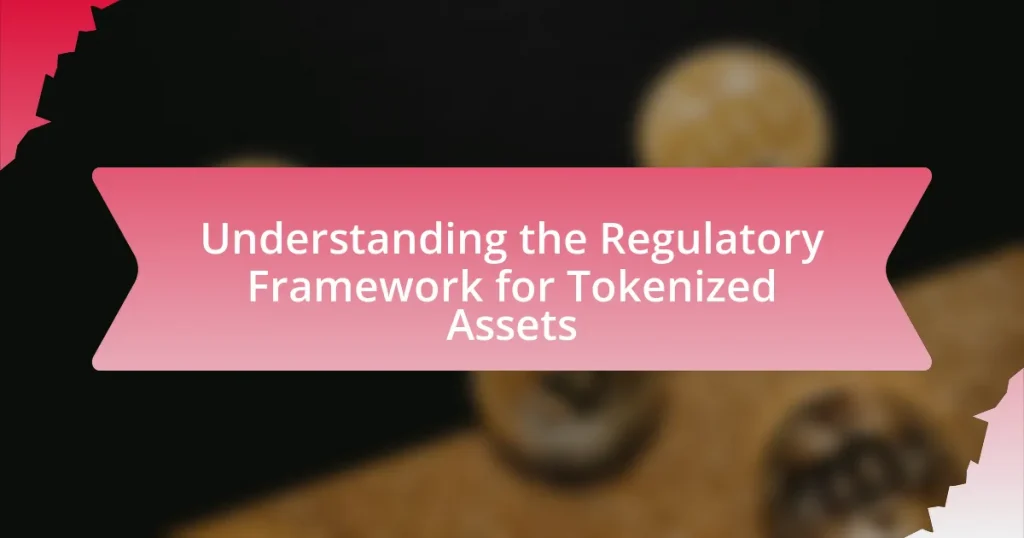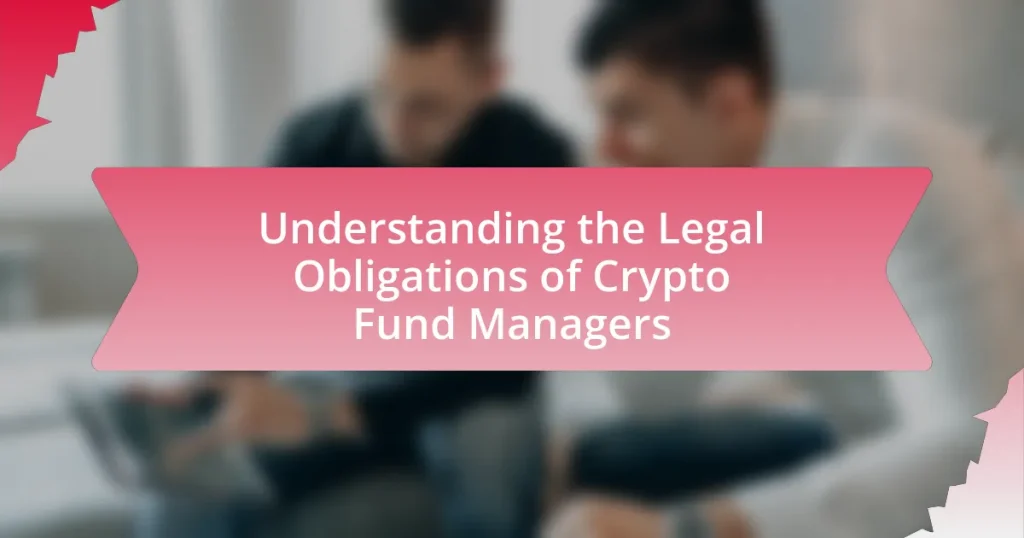A Regulatory Risk Assessment for Crypto Investment Funds is a critical evaluation process aimed at identifying and mitigating potential regulatory risks associated with cryptocurrency investments. This article outlines the importance of such assessments in navigating the complex and evolving regulatory landscape, highlighting key components, potential challenges, and the impact of regulatory risks on fund performance. It details the steps involved in conducting an assessment, including identifying relevant regulations, evaluating compliance risks, and implementing mitigation strategies. Additionally, the article discusses best practices for ongoing monitoring and stakeholder engagement to enhance the effectiveness of the assessment process, ultimately ensuring compliance and protecting investor interests in a volatile market.
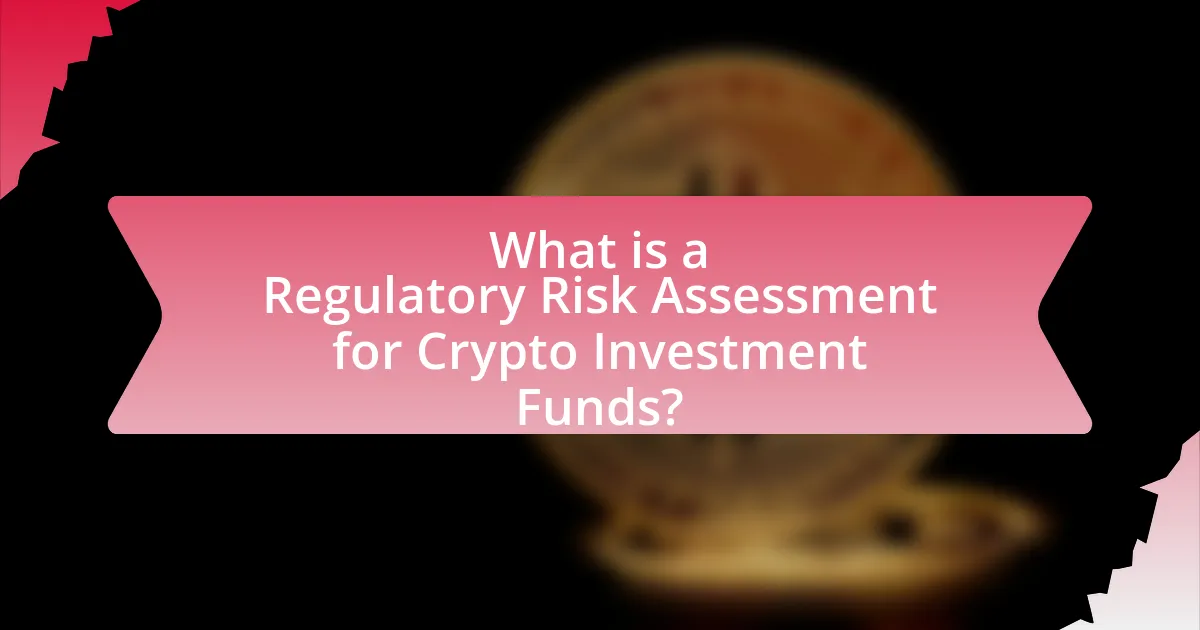
What is a Regulatory Risk Assessment for Crypto Investment Funds?
A Regulatory Risk Assessment for Crypto Investment Funds is a systematic evaluation process that identifies, analyzes, and mitigates potential regulatory risks associated with investing in cryptocurrencies. This assessment is crucial due to the evolving regulatory landscape surrounding digital assets, which can impact compliance, operational practices, and financial stability. By conducting this assessment, investment funds can ensure adherence to applicable laws and regulations, thereby reducing the likelihood of legal penalties or operational disruptions. The necessity for such assessments is underscored by the increasing scrutiny from regulatory bodies worldwide, which have implemented various frameworks to govern cryptocurrency activities.
Why is a Regulatory Risk Assessment important for Crypto Investment Funds?
A Regulatory Risk Assessment is important for Crypto Investment Funds because it identifies and mitigates potential legal and compliance risks associated with cryptocurrency investments. This assessment helps funds navigate the complex regulatory landscape, which varies significantly across jurisdictions and is subject to rapid changes. For instance, in 2021, the Financial Action Task Force (FATF) issued guidelines that emphasized the need for compliance with anti-money laundering (AML) and counter-terrorism financing (CTF) regulations, highlighting the necessity for funds to conduct thorough risk assessments to avoid legal penalties. By proactively addressing these risks, investment funds can protect their assets, maintain investor confidence, and ensure long-term sustainability in a highly volatile market.
What are the potential regulatory challenges faced by Crypto Investment Funds?
Crypto Investment Funds face several potential regulatory challenges, including compliance with anti-money laundering (AML) and know your customer (KYC) regulations, which require thorough verification of investor identities and monitoring of transactions. Additionally, the lack of a unified regulatory framework across jurisdictions complicates operations, as funds must navigate varying laws and regulations in different countries. Furthermore, the classification of cryptocurrencies as securities or commodities can lead to differing regulatory requirements, impacting how funds are structured and operated. The evolving nature of regulations, such as the European Union’s Markets in Crypto-Assets (MiCA) framework, adds uncertainty, as funds must adapt to new rules that may emerge. These challenges can hinder the ability of Crypto Investment Funds to operate efficiently and attract investors.
How can regulatory risks impact the performance of Crypto Investment Funds?
Regulatory risks can significantly impact the performance of Crypto Investment Funds by introducing uncertainty and potential financial penalties. When regulatory bodies impose new rules or change existing regulations, funds may face increased compliance costs, which can reduce profitability. For instance, the introduction of stricter anti-money laundering (AML) and know-your-customer (KYC) regulations can require funds to invest in more robust compliance systems, diverting resources from investment activities. Additionally, regulatory actions can lead to market volatility; for example, announcements of potential crackdowns on cryptocurrency trading have historically resulted in sharp declines in asset prices, directly affecting fund valuations. Therefore, the interplay between regulatory changes and market dynamics can create a challenging environment for Crypto Investment Funds, influencing their overall performance and investor confidence.
What are the key components of a Regulatory Risk Assessment?
The key components of a Regulatory Risk Assessment include identifying regulatory requirements, assessing compliance risks, evaluating the impact of non-compliance, and implementing risk mitigation strategies. Identifying regulatory requirements involves understanding the specific laws and regulations applicable to the crypto investment fund, such as anti-money laundering (AML) and know your customer (KYC) regulations. Assessing compliance risks entails analyzing the likelihood of non-compliance and its potential consequences. Evaluating the impact of non-compliance requires quantifying the financial and reputational damage that could arise from regulatory breaches. Finally, implementing risk mitigation strategies involves developing policies and procedures to ensure adherence to regulations, thereby minimizing the identified risks.
What regulatory frameworks should be considered in the assessment?
The regulatory frameworks that should be considered in the assessment of crypto investment funds include the Financial Action Task Force (FATF) guidelines, the European Union’s Markets in Crypto-Assets (MiCA) regulation, and the U.S. Securities and Exchange Commission (SEC) regulations. These frameworks provide essential guidelines for anti-money laundering (AML) practices, investor protection, and market integrity. For instance, the FATF guidelines emphasize the need for jurisdictions to implement AML measures for virtual assets, while MiCA aims to create a comprehensive regulatory framework for crypto assets within the EU, ensuring transparency and consumer protection. The SEC’s regulations focus on the classification of cryptocurrencies as securities, which impacts compliance requirements for investment funds.
How do jurisdictional differences affect the assessment process?
Jurisdictional differences significantly impact the assessment process by creating variations in regulatory frameworks, compliance requirements, and enforcement mechanisms. For instance, jurisdictions like the United States and the European Union have distinct regulations governing cryptocurrency, which can lead to different risk profiles for investment funds operating in these regions. The U.S. may impose stricter anti-money laundering (AML) and know-your-customer (KYC) regulations compared to some other jurisdictions, affecting how funds assess their operational risks. Additionally, the Financial Action Task Force (FATF) guidelines, which many jurisdictions adopt differently, can influence the level of scrutiny applied to crypto investments. This divergence necessitates tailored assessment strategies that account for local laws and regulatory expectations, ensuring that investment funds remain compliant and mitigate risks effectively.
What steps are involved in conducting a Regulatory Risk Assessment?
The steps involved in conducting a Regulatory Risk Assessment include identifying applicable regulations, assessing compliance requirements, evaluating potential risks, analyzing the impact of those risks, and developing a mitigation strategy.
First, identifying applicable regulations involves researching laws and guidelines relevant to crypto investment funds, such as anti-money laundering (AML) and know your customer (KYC) regulations. Next, assessing compliance requirements entails reviewing the specific obligations imposed by these regulations on the fund’s operations.
Following this, evaluating potential risks involves determining the likelihood and severity of non-compliance or regulatory changes that could affect the fund. Analyzing the impact of those risks requires understanding how they could affect the fund’s financial stability and reputation. Finally, developing a mitigation strategy includes creating action plans to address identified risks, ensuring ongoing compliance, and preparing for regulatory changes.
These steps are essential for ensuring that crypto investment funds operate within legal frameworks and minimize exposure to regulatory penalties.
How do you identify relevant regulations for Crypto Investment Funds?
To identify relevant regulations for Crypto Investment Funds, one must analyze the legal frameworks established by financial regulatory authorities in the jurisdictions where the funds operate. This involves reviewing guidelines from entities such as the Securities and Exchange Commission (SEC) in the United States, the Financial Conduct Authority (FCA) in the United Kingdom, and the European Securities and Markets Authority (ESMA) in the European Union. These authorities provide specific regulations regarding the classification of cryptocurrencies, investor protections, and compliance requirements for fund managers. For instance, the SEC has classified certain cryptocurrencies as securities, which subjects them to specific regulatory obligations under the Securities Act of 1933. By systematically examining these regulations, fund managers can ensure compliance and mitigate legal risks associated with crypto investments.
What methods can be used to evaluate compliance risks?
To evaluate compliance risks, organizations can utilize methods such as risk assessments, audits, compliance checklists, and benchmarking against industry standards. Risk assessments involve identifying potential compliance issues and analyzing their impact, which helps prioritize risks based on severity and likelihood. Audits provide an independent review of compliance processes and controls, revealing gaps and areas for improvement. Compliance checklists serve as practical tools to ensure all regulatory requirements are met systematically. Benchmarking against industry standards allows organizations to compare their compliance practices with peers, identifying best practices and areas needing enhancement. These methods collectively enhance the understanding and management of compliance risks in the context of regulatory risk assessments for crypto investment funds.
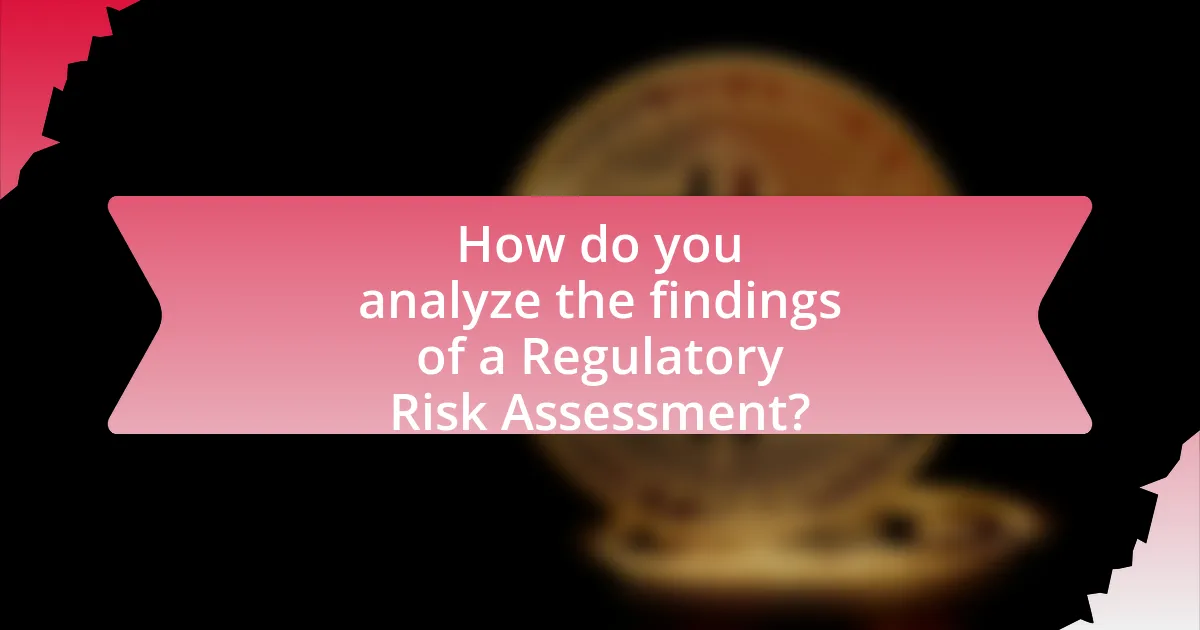
How do you analyze the findings of a Regulatory Risk Assessment?
To analyze the findings of a Regulatory Risk Assessment, one must systematically evaluate the identified risks against regulatory requirements and industry standards. This involves categorizing risks based on their likelihood and potential impact, assessing the effectiveness of existing controls, and determining any gaps in compliance. For instance, a study by the Financial Action Task Force (FATF) highlights that jurisdictions must assess risks related to money laundering and terrorist financing, which can inform the analysis of regulatory risks in crypto investment funds. By comparing the assessment findings with regulatory frameworks, organizations can prioritize risk mitigation strategies and ensure adherence to compliance obligations.
What tools can assist in analyzing regulatory risks?
Tools that can assist in analyzing regulatory risks include compliance management software, risk assessment frameworks, and regulatory technology (RegTech) solutions. Compliance management software, such as LogicManager or ComplyAdvantage, helps organizations track regulatory changes and assess their impact on operations. Risk assessment frameworks, like the COSO ERM framework, provide structured methodologies for identifying and evaluating risks. RegTech solutions, such as Ayasdi or Riskified, leverage artificial intelligence to automate compliance processes and enhance risk analysis. These tools collectively enable organizations to effectively monitor, assess, and mitigate regulatory risks in the context of crypto investment funds.
How can data analytics enhance the assessment process?
Data analytics can enhance the assessment process by providing actionable insights through the analysis of large datasets, which improves decision-making and risk evaluation. By leveraging advanced analytical techniques, organizations can identify patterns, trends, and anomalies in data related to crypto investment funds, allowing for a more comprehensive understanding of potential regulatory risks. For instance, a study by Deloitte found that firms utilizing data analytics in risk assessments reported a 30% increase in the accuracy of their risk evaluations, demonstrating the effectiveness of data-driven approaches in enhancing assessment processes.
What role does stakeholder feedback play in the analysis?
Stakeholder feedback plays a critical role in the analysis by providing insights that enhance the understanding of regulatory risks associated with crypto investment funds. This feedback helps identify potential concerns, expectations, and perceptions from various stakeholders, including investors, regulators, and industry experts. By integrating this feedback into the analysis, organizations can better align their risk assessment processes with stakeholder priorities, leading to more informed decision-making. Research indicates that incorporating stakeholder perspectives can improve the accuracy of risk assessments, as evidenced by studies showing that organizations that actively seek and utilize stakeholder input experience a 30% increase in risk identification effectiveness.
How can the results of the assessment inform decision-making?
The results of the assessment can inform decision-making by providing a clear understanding of the regulatory risks associated with crypto investment funds. This understanding allows fund managers to identify potential compliance issues, prioritize risk mitigation strategies, and allocate resources effectively. For instance, a study by the Financial Action Task Force (FATF) highlights that risk assessments enable organizations to tailor their compliance programs to specific regulatory environments, thereby enhancing their ability to navigate complex legal frameworks. By utilizing assessment results, decision-makers can make informed choices that align with regulatory requirements and reduce the likelihood of legal penalties.
What strategies can be implemented to mitigate identified risks?
To mitigate identified risks in the context of regulatory risk assessment for crypto investment funds, implementing a combination of compliance frameworks, risk management protocols, and continuous monitoring is essential. Compliance frameworks, such as adhering to Anti-Money Laundering (AML) and Know Your Customer (KYC) regulations, help ensure that funds operate within legal boundaries, reducing the risk of regulatory penalties. Risk management protocols, including regular audits and assessments, allow funds to identify vulnerabilities and address them proactively. Continuous monitoring of regulatory changes and market conditions enables funds to adapt swiftly to new risks, ensuring ongoing compliance and risk mitigation. These strategies collectively enhance the resilience of crypto investment funds against regulatory risks.
How should findings be communicated to stakeholders?
Findings should be communicated to stakeholders through clear, concise reports and presentations that highlight key insights and actionable recommendations. Effective communication involves using visual aids such as charts and graphs to illustrate data trends, ensuring that complex information is easily digestible. Additionally, stakeholders should receive tailored summaries that address their specific interests and concerns, fostering engagement and understanding. Research indicates that visual communication can enhance retention of information by up to 65%, making it a vital component in stakeholder presentations.
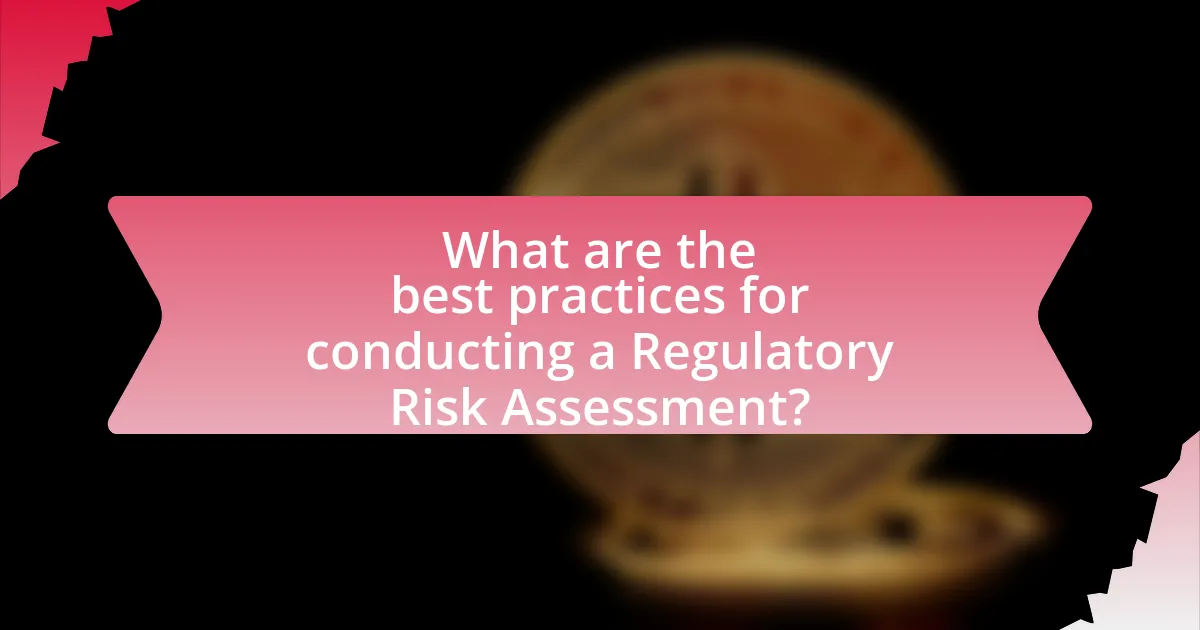
What are the best practices for conducting a Regulatory Risk Assessment?
The best practices for conducting a Regulatory Risk Assessment include identifying applicable regulations, assessing compliance gaps, and implementing a risk management framework. First, organizations must identify all relevant regulations that pertain to their operations, particularly in the context of crypto investment funds, as regulations can vary significantly by jurisdiction. Next, a thorough assessment of compliance gaps should be conducted to determine where current practices do not meet regulatory requirements, which can involve reviewing internal policies and procedures against regulatory standards. Finally, implementing a risk management framework allows organizations to prioritize risks, develop mitigation strategies, and establish monitoring processes to ensure ongoing compliance. These practices are essential for minimizing legal exposure and ensuring that the organization operates within the regulatory landscape effectively.
How often should a Regulatory Risk Assessment be conducted?
A Regulatory Risk Assessment should be conducted at least annually. This frequency aligns with best practices in risk management, ensuring that organizations remain compliant with evolving regulations and can effectively identify and mitigate potential risks. Regulatory environments, particularly in the crypto sector, are dynamic, necessitating regular assessments to adapt to new legal requirements and market conditions.
What factors influence the frequency of assessments?
The frequency of assessments is influenced by regulatory requirements, the volatility of the crypto market, and the specific risk profile of the investment fund. Regulatory bodies often mandate periodic assessments to ensure compliance with evolving laws, which can vary in frequency based on jurisdiction. The inherent volatility of cryptocurrencies necessitates more frequent evaluations to manage risks effectively, as market conditions can change rapidly. Additionally, the unique risk profile of each investment fund, including its investment strategy and asset allocation, can dictate how often assessments should be conducted to adequately address potential risks.
How can ongoing monitoring improve risk management?
Ongoing monitoring enhances risk management by providing real-time insights into potential threats and vulnerabilities. This continuous oversight allows organizations to identify emerging risks promptly, enabling proactive measures to mitigate them. For instance, a study by the Global Association of Risk Professionals indicates that firms employing ongoing monitoring can reduce risk exposure by up to 30% compared to those relying solely on periodic assessments. By integrating data analytics and automated reporting, ongoing monitoring ensures that risk management strategies remain relevant and effective in the rapidly evolving landscape of crypto investment funds.
What common pitfalls should be avoided during the assessment process?
Common pitfalls to avoid during the assessment process include inadequate data collection, lack of stakeholder engagement, and failure to update risk assessments regularly. Inadequate data collection can lead to incomplete risk profiles, as seen in studies where insufficient data resulted in misjudged risk levels. Lack of stakeholder engagement often results in overlooking critical insights, which can compromise the assessment’s effectiveness. Additionally, failing to update risk assessments can render them obsolete, as regulatory environments and market conditions evolve rapidly, necessitating continuous review to ensure relevance and accuracy.
How can biases affect the assessment outcomes?
Biases can significantly distort assessment outcomes by influencing the interpretation of data and the decision-making process. For instance, confirmation bias may lead assessors to favor information that supports their preconceived notions about a crypto investment fund, while disregarding contradictory evidence. Research indicates that cognitive biases can result in systematic errors in judgment, affecting the reliability of risk assessments. A study published in the Journal of Behavioral Finance highlights that biases can lead to overconfidence in predictions, which can skew the perceived risk associated with investments. Thus, biases can compromise the objectivity and accuracy of regulatory risk assessments in the context of crypto investment funds.
What are the consequences of overlooking key regulations?
Overlooking key regulations can lead to severe legal and financial repercussions for crypto investment funds. Non-compliance may result in hefty fines, legal actions, and potential shutdowns by regulatory authorities, as evidenced by the SEC’s enforcement actions against firms failing to adhere to securities laws. Additionally, overlooking regulations can damage a fund’s reputation, eroding investor trust and leading to decreased capital inflow. Historical instances, such as the collapse of Mt. Gox, highlight how regulatory neglect can precipitate significant financial losses and operational failures.
What practical tips can enhance the effectiveness of a Regulatory Risk Assessment?
To enhance the effectiveness of a Regulatory Risk Assessment for crypto investment funds, implement a structured framework that includes comprehensive data collection, stakeholder engagement, and continuous monitoring. Comprehensive data collection ensures that all relevant regulatory requirements and potential risks are identified, while stakeholder engagement facilitates diverse perspectives and insights, improving the assessment’s accuracy. Continuous monitoring allows for timely updates to the risk assessment in response to regulatory changes or emerging risks, thereby maintaining its relevance and effectiveness. These practices are supported by the Financial Stability Board’s guidelines, which emphasize the importance of thorough risk identification and stakeholder collaboration in regulatory assessments.






